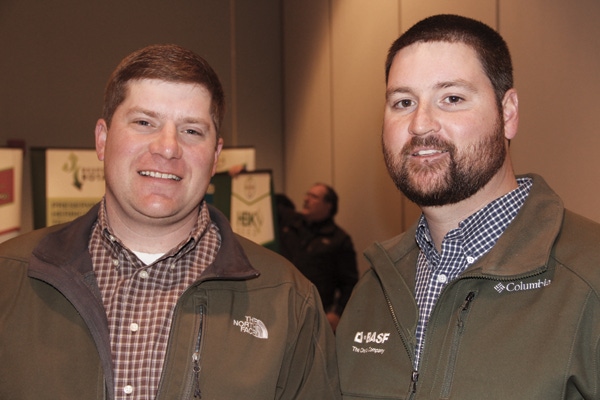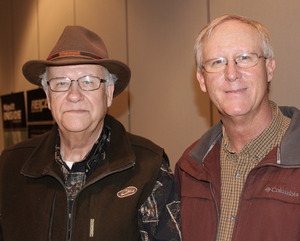
“It would take 90 hours of scouting for southwestern corn borer egg masses to get the same precision you can get with just four pheromone traps," says Fred Musser, associate professor of entomology and plant pathology at Mississippi State University. "I don’t know of anyone who wants to spend 90 hours on making a single decision.”

If you grow non-Bt corn and you’ve spent a lot of sweaty time in fields scouting for southwestern corn borer egg masses and larvae, Fred Musser has relief for you.
Pheromone traps are just as effective, take less time, and are cheap, he says.
“The big problem with scouting for egg masses/larvae is that it’s incredibly time-consuming,” he said at the annual meeting of the Mississippi Agricultural Consultants Association at Mississippi State University. “You’re out there in 15-feet tall corn, early silk stage, miserable heat and humid conditions, trying to sort through massive amounts of leaf tissue, searching for an extremely small egg mass that’s very easy to overlook.”
Because of this, says Musser, associate professor of entomology and plant pathology at MSU, many growers and consultants are less than enthusiastic about scouting for the pest, and even those well-trained in the procedure will often obtain insufficient information on which to base a treatment decision.
Corn insect control: Now’s time to develop game plan for 2014 crop

FRED MUSSER
In a study from 2007-2010, with support from the Mississippi Corn Promotion Board, five traps were placed around commercial non-Bt corn fields and checked weekly. At the same time, physical inspections of corn plants were done weekly to look for eggs and larvae. As harvest neared, stalks were split to determine how much tunneling had occurred.
“These pheromone traps are very specific — they catch very few insects other than southwestern corn borer,” Musser says. “And you can place them where they’re easily accessible.”
Results showed that pheromone traps and egg sampling “were about equal in how we were able to predict the amount of tunneling — there wasn’t much difference in their accuracy. The big difference was in the amount of effort required.
“What the data tell me is that, with the egg scouting method, we were missing many of the egg masses. And this was by people we’d trained and who knew what to look for.”
Savings of time, effort
Musser says it would be necessary to look at more than 10,000 corn plants to get adequate data for accuracy of predictability using the egg scouting method.
“That’s versus four pheromone traps to achieve an equivalent result. I think it’s pretty obvious which choice most folks would make.”

ROBERT MASSEY, left, Massey Agricultural Consultants, Senatobia, Miss., and Benny Graves, executive director, Mississippi Sweet Potato Council, Vardaman, Miss., take a break during the MACA conference.
“It would take 90 hours of scouting for egg masses to get the same precision you can get with just four pheromone traps. I don’t know of anyone who wants to spend 90 hours on making a single decision.”
This system allows “a big savings in time and effort, and you still get the quality of data you want,” Musser says.
The cost of a simple plastic bucket trap, plus lure for a season, runs about $14. “If you take care of them, they can last for four years.”
Four traps are recommended per decision unit. “You can make decisions on a field-by-field basis or farm-by-farm basis. You have options on how you want to get your data and on what scale you want to do it.”
Recommendations for trap placement, Musser says: “Avoid trees or anything that blocks wind flow. Place the trap outside the field, not inside — air flow is critical. Keep any grass or weeds from growing tall around the trap and limiting air flow. Replace lures every two to three weeks.”

SOUTHWESTERN CORN BORER (University of Arkansas photo)
The Mississippi treatment threshold for southwestern corn borer has been revised, Musser notes. “It was 25 percent egg masses/larvae at the early vegetative stage; now, it’s 50 moths per pheromone trap or 5 percent egg masses. In the early reproductive stage, the threshold is now 100 moths per pheromone trap or 10 percent egg masses.”
RELATED: Insect pest control in Mid-South corn
A R4 stage or later, he says, “we recommend no treatment — corn will be at dent stage before the eggs hatch and you’re not looking at any economic yield loss. There could be stalk boring and potential lodging, in which case you might want to move up your harvest date.”
In Bt corn, Musser says, “the technology is still working splendidly, and nobody I’m aware of has reported any southwestern corn borer survivors. We hope it will stay that way for a long time.
“The biggest densities we’ve seen of southwestern corn borer have been where non-Bt corn has been planted for several years. In those situations, they can build up locally and become a problem. We saw a number of instances of this in 2013.”
Changes in control recommendations
Other changes in insect control recommendations include:
• Soybeans: Recommended termination of insecticides for defoliating insects has been changed from R7 to R6.5. “Data we collected on defoliation in 2009-10 show less yield loss during R6,” Musser says. “By terminating at R6.5, you won’t have reached economic injury level before beans reach R7 stage.
• Bean leaf beetles: “The old threshold was 20% defoliation during reproductive stages or 2 insects per sweep and we were triggering a lot of unnecessary sprays. We’ve changed it to 20 percent defoliation or 50% plants with pod feeding and eliminated the 2 insect/sweep threshold.”
• Stink bugs: Damage at R3 and R4 can cause “pretty big yield losses from relatively low densities of stink bugs,” Musser says, “but at R6-R7, the only loss is quality. In most years in most situations, they don’t do enough quality damage to cause economic loss. So, we’ve have changed our late season R6 threshold to 20 stink bugs per 25 sweeps.”
• Three-cornered alfalfa hopper: “Our threshold is 2 insects per sweep during reproductive stage. Later in the season, it’s still 2 per sweep, but our ongoing research suggests it could be much higher than 2. In cage studies by a graduate student,” Musser says, “we were getting girdling, but we’ve not been able to document yield loss, even as high as 8 adult insects per sweep.
“Termination has been moved back to R6 instead of R7, because they’re just not doing that much damage at that point.”
Ag news delivered daily to your inbox: Subscribe to Delta Farm Press Daily.
About the Author(s)
You May Also Like



